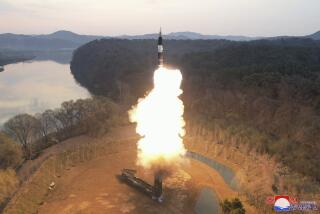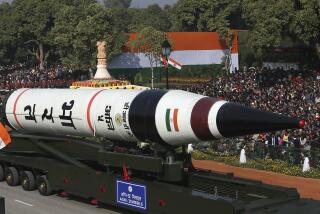Why the B-52 bomber will fly for 100 years

The Air Force just can’t let go of the B-52.
In the world of heavy bombers, none has prevailed as long as the B-52 Stratofortress. The Cold Warrior joined the U.S. arsenal in 1954, eventually becoming part of a nuclear triad that, along with strategic missiles and submarines, was aimed at giving the Soviet Union pause. After the Berlin Wall fell, it slowly became an aerial jack-of-all-trades. With its long range, minimal operating cost and ability to handle a wider array of weapons than any other aircraft, it just didn’t make sense to get rid of it.
Under the Air Force’s current bomber plans, the B-52 will fly until 2050 — just shy of its 100th birthday. While this prospective centenary has been cause for some breathless coverage, little has been said about how a complex piece of machinery built during the Korean War is still useful in 2018, let alone 2050. What is the B-52’s secret?
That secret is flexibility. Boeing Co. produced more than 740 B-52s since the first one rolled out. It’s had many nicknames — the most apt at this moment being “Stratosaurus.” Like any other well-regarded employee who manages to survive, and even thrive, in a constantly changing organization, the B-52 has always found an important role.
Originally deployed as a long-range, high-altitude nuclear bomber, it became a carpet-bombing specialist in Vietnam, a fixture in the skies over Iraq during the first Gulf War and, shortly after Sept. 11, 2001, a fearsome sight above the mountains of eastern Afghanistan.
These days, it’s routinely used as air support for U.S. ground troops in the Middle East, often deploying precision-guided missiles. Though retrofitted repeatedly over the decades to meet its ever-changing mandate, the B-52 retains its original mission: delivering nuclear weapons to target. Last month, the Pentagon deployed six B-52s to Guam, along with three B-2 stealth bombers, amid heightened tensions with North Korea. The B-52 is the only heavy bomber in the U.S. fleet that can carry both conventional and thermonuclear bombs.
The average age of the 75 B-52s currently in service is 55 years old — as in, they first took flight when President John F. Kennedy occupied the Oval Office. Compared with modern aircraft, the B-52 is neither particularly fast nor stealthy. But that doesn’t really matter, given its current uses. “We have few adversaries that can challenge our air superiority,” said George Ferguson, a senior aerospace and defense analyst with Bloomberg Intelligence. “So a lot of B-52s work as the large ordnance carriers, with no stealth or speed characteristics.”
Flying the B-52 for almost a century makes sense because of its “total cost perspectives,” plus its mission capability, supply and maintenance needs relative to flying hours, the Air Force said in a Feb. 12 statement.
At the pricier end of the spectrum, the Pentagon is budgeting almost $17 billion over the next five years to develop the new B-21 Raider from Northrop Grumman Corp., which will replace the current fleet of B-1B Lancer and B-2 Spirit bombers. The B-21, which may fly as a “crew-optional” aircraft, is expected to join the Air Force fleet in the mid-2020s. The Pentagon plans to buy at least 100 B-21s, spending about $97 billion.
Backing it up will be the Stratosaurus. At the Cold War’s peak in the 1960s, the Strategic Air Command kept as many as a dozen nuclear-armed B-52s aloft continuously to provide an airborne deterrent against the Soviet Union. Operation Chrome Dome, as the aerial mission was dubbed, aimed to assure the U.S. a strike capability even if a Soviet nuclear attack were to disable ground-based American missiles. The advent of nuclear missile-armed submarines diminished the importance of the other legs of the triad, but the B-52 endured.
The heavy bomber also played a role in President Richard Nixon’s “madman theory” to persuade the Russians that he was irrational and unstable, willing to launch a nuclear war to force peace talks to end the Vietnam conflict. In October 1969, Nixon dispatched 18 B-52s toward Russia, where they flew for three days, poking at Soviet air defenses in an exercise dubbed Giant Lance.
Now, in addition to the plans for its extended lifespan, the military has announced yet another bit of elective surgery for the ancient planes, currently based at Barksdale Air Force Base in Louisiana and Minot Air Force Base in North Dakota. The Air Force will seek funds to replace the engines on its 75 B-52s, each of which has eight Pratt & Whitney power plants. Replacing all eight engines on all 75 planes is likely to cost several billion dollars, Ferguson said.
The decisions were detailed this week as part of the Trump administration’s budget request to Congress. The 1980s-era supersonic B-1 and the radar-evading B-2 fielded a decade later will be phased out gradually as new B-21s enter service, Air Force Secretary Heather Wilson said. The B-21 will offer the U.S. the ability to strike with speed and stealth, “but once we own the skies, the B-52 can drop ordnance better than most others,” Ferguson said. “And hey,” she added, “it’s paid for.”
Bachman writes for Bloomberg.






